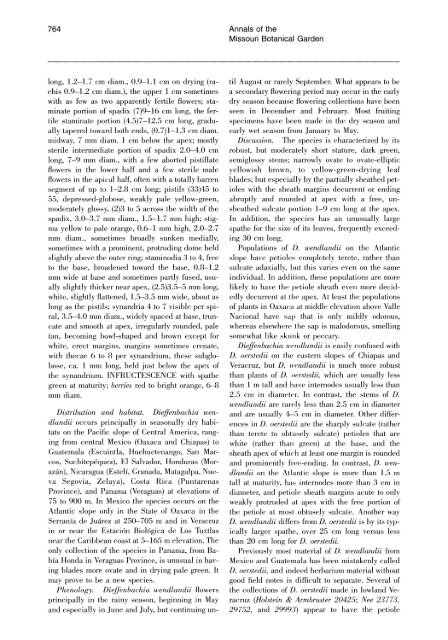l - CNCFlora
l - CNCFlora
l - CNCFlora
Create successful ePaper yourself
Turn your PDF publications into a flip-book with our unique Google optimized e-Paper software.
764<br />
Annals of the<br />
Missouri Botanical Garden<br />
long, 1.2-1.7 cm diam., 0.9-1.1 cm on drying (ra- til August or rarely September. What appears to be<br />
chis 0.9-1.2 cm diam.), the upper 1 cm sometimes a secondary flowering period may occur in the early<br />
with as few as two apparently fertile flowers, sta- dry season because flowering collections have been<br />
minate portion of spadix (7)9-16 cm long, the fer- seen in December and February. Most fruiting<br />
tile staminate portion (4.5)7-12.5 cm long, gradu- specimens have been made in the dry season and<br />
ally tapered toward both ends, (0.7)1-1.3 cm diam. early wet season from January to May.<br />
midway, 7 mm diam. 1 cm below the apex; mostly Discussion. The species is characterized by its<br />
sterile intermediate portion of spadix 2.0 l.0 cm robust, but moderately short stature, dark green,<br />
long, 7-9 mm diam., with a few aborted pistillate semiglossy stems; narrowly ovate to ovate-elliptic<br />
flowers in the lower half and a few sterile male yellowish brown, to yellow-green-drying leaf<br />
flowers in the apical half, often with a totally barren blades; but especially by the partially sheathed petsegment<br />
of up to 1-2.8 cm long; pistils (33)45 to ioles with the sheath margins decurrent or ending<br />
55, depressed-globose, weakly pale yellow-green, abruptly and rounded at apex with a free, unmoderately<br />
glossy, (2)3 to 5 across the width of the sheathed sulcate portion 1-9 cm long at the apex.<br />
spadix, 3.0-3.7 mm diam., 1.5-1.7 mm high; stig- In addition, the species has an unusually large<br />
ma yellow to pale orange, 0.6-1 mm high, 2.0-2.7 spathe for the size of its leaves, frequently exceedmm<br />
diam., sometimes broadly sunken medially, ing 30 cm long.<br />
sometimes with a prominent, protruding dome held Populations of 1). wendlandii on the Atlantic<br />
slightly above the outer ring; staminodia 3 to 4, free slope have petioles completely terete, rather than<br />
to the base, broadened toward the base, 0.8-1.2 sulcate adaxially, })ut this varies even on the same<br />
mm wide at base and sometimes partly fused, usu- individual. In ad(lition, these populations are more<br />
ally slightly thicker near apex, (2.5)3.5-5 mm long, likely to have the ^)etiole sheath even more decidwhite,<br />
slightly flattened, 1.5-3.5 mm wide, about as edly decurrent at the apex. At least the populations<br />
long as the pistils; synandria 4 to 7 visible per spi- of plants in Oaxaccl at middle elevation above Valle<br />
ral, 3.5 l.0 mm diam., widely spaced at base, trun- Nacional have sal) that is only mildly odorous,<br />
cate and smooth at apex, irregularly rounded, pale whereas elsewhere the sap is malodorous, smelling<br />
tan, becoming bowl-shaped and brown except for somewhat like sk ll 1l k or peccary.<br />
white, erect margins, margins sometimes crenate, DieJ%enbachia 1lperldlandii is easily confused with<br />
with thecae 6 to 8 per synandrium, these subglo- D. oerstedii on the eastern slopes of Chiapas and<br />
bose, ca. 1 mm long, held just below the apex of Veracruz, but D. Ilnendlandii is much more robust<br />
the synandrium. INFRUCTESCENCE with spathe than plants of D. oerstediip which are usually less<br />
green at maturity; berries red to bright orange, 6-8 than 1 m tall and have internodes usually less than<br />
mm diam.<br />
2.5 cm in diameter: In contrast, the stems of D.<br />
wendlandii are rarely less than 2.5 cm in diameter<br />
Distribution and habitat. Dieffenbachia wen- and are usually 4-5 cm in diameter. Other differdlandii<br />
occurs principally in seasonally dry habi- ences in D. oerstedii are the sharply sulcate (rather<br />
tats on the Pacific slope of Central America, rang- than terete to obtusely sulcate) petioles that are<br />
ing from central Mexico (Oaxaca and Chiapas) to white (rather than green) at the base, and the<br />
Guatemala (Escuintla, Huehuetenango, San Mar- sheath apex of which at least one margin is rounded<br />
cos, Suchitepequez), E1 Salvador, Honduras (Mor- and prominently free-ending. In contrast, D. wenazan),<br />
Nicaragua (Esteli, Granada, Matagalpa, Nue- dlandii on the Atlantic slope is more than 1.5 m<br />
va Segovia, Zelaya), Costa Rica (Puntarenas tall at maturity, has internodes more than 3 cm in<br />
Province), and Panama (Veraguas) at elevations of diameter, and petiole sheath margins acute to only<br />
75 to 900 m. In Mexico the species occurs on the weakly protruded at apex with the free portion of<br />
Atlantic slope only in the State of Oaxaca in the the petiole at most obtusely sulcate. Another way<br />
Serrania de Juarez at 250-705 m and in Veracruz D. wendlandii differs from D. oerstedii is by its typin<br />
or near the Estacion Biologica de Los Tuxtlas ically larger spathe, over 25 cm long versus less<br />
near the Caribbean coast at 5-165 m elevation. The than 20 cm long for D. oerstedii.<br />
only collection of the species in Panama, from Ba- Previously most material of D. wendlandii from<br />
hia Honda in Veraguas Province, is unusual in hav- Mexico and Guatemala has been mistakenly called<br />
ing blades more ovate and in drying pale green. It D. oerstedii, and indeed herbarium material without<br />
may prove to be a new species.<br />
good field notes is difficult to separate. Several of<br />
Phenology. DiefNfenbachia wendlandii flowers the collections of D. oerstedii made in lowland Veprincipally<br />
in the rainy season, beginning in May racruz (Holstein & Armbruster 20425; Nee 23 773^<br />
and especially in June and July, but continuing un- 29752 and 29993) appear to have the petiole

















